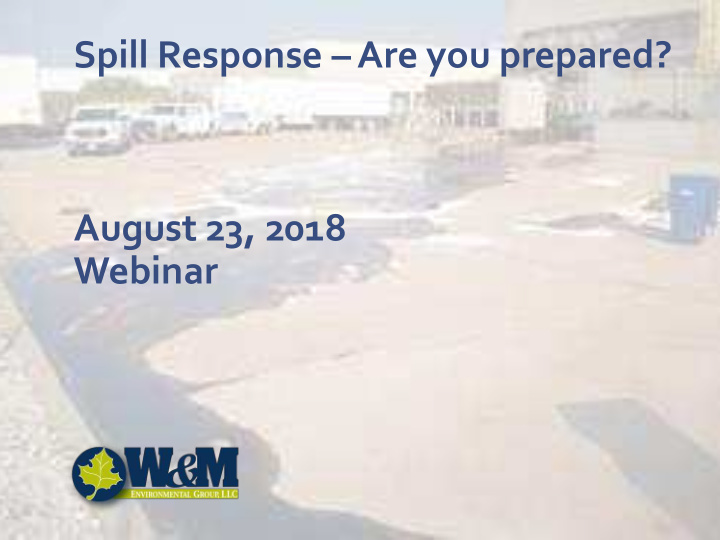



Spill Response – Are you prepared? August 23, 2018 Webinar
Meet our Presenters Vs. Austin Heider is an Environmental Diana Rader, P.G. has overseen many Geoscience graduate of Texas A&M spill responses for large and small University. His experience includes spills at sites all across Texas. She is multiple spill response and remediation a Principal and Regional Manager projects. He is a Principal and Division based in W&M’s Austin office. Manager in W&M’s Houston office.
What is the difference between Emergency Response and Spill Response?
Who do I contact? • Environmental emergencies, spills, discharges, or an air release require notice to state and federal agencies. State: • State of Texas Spill-Reporting Hotline and the State Emergency Response Commission (SERC): 1-800-832- 8224 • TCEQ Regional Office Federal: • National Response Center: 1-800-424-8802 Texas 811: • Emergency Response Ticket: 1-800-344-8377 • https://www.texas811.org/
Reportable Quantities • 40 CFR § 302.4 – EPA Hazardous Substance & Reportable Quantities (Table 302.4 – Final RQ)
Regulatory Agency/Jurisdiction
7 KEYS TO SUCCESS
7 Keys to Success 1. Who is in charge? 2. Remediation Contractors/Consultants 3. Waste Management 4. Cleanup Requirements 5. Safety 6. Assessment and Path to Closure 7. Reporting
Who’s in Charge?
Who you gonna call?
Poll Question Does your facility have a Spill Response Plan?
Remediation Contractors/Consultants • “48 - hour team” o Response Time • Approved & Established o Insurance, Certifications, Training o Equipment, Personnel, Experience • Location o Where are your facilities? o What is the response time?
Waste Management • Contaminated soils • Contaminated liquids
Waste Management • Waste Classification o Identify disposal facility o Lab testing to characterize o Waste profile • Wastes with special needs o PCBs, asbestos, radioactive o Special disposal facilities
Waste Management o Are there other options? o Recycling o Landfarming
Poll Question How do you know if your spill is reportable?
Cleanup Requirements • Which Regulatory Agency? • TCEQ Spills • Identify chemical on concern (COCs) • Removal of source to background • RRC Spills • Identify COCs • 1% TPH removal within 1-year, BTEX & additional COCs require removal to PLs • Who owns/leases the land? • Additional cleanup per lease agreements
Safety
Poll Question How many past spills have gone perfectly to plan?
Assessment and Path to Closure • TCEQ – 30 TAC 327 (Spill Rules) • Sample, delineate, & remediate – All affected media • 180 days to remediation to background concentrations or pre-existing conditions. • After 180 days ,TCEQ Regulatory Enrollment: Corrective Action • RRC – Statewide Rules 8, 20, & 91 • Sample, delineate, & remediate – All affected media • 1% total TPH removal within 1-year • BTEX and additional COC removal to PLs • Enrollment in Operator Cleanup Program (OCP) or VCP
Reporting • Documentation is key! • Regulatory Reporting • TCEQ – 30-day status report; 180-day closure report • RRC – Case by Case dependent; requires immediate notification & remediation • Internal Reporting • Daily field reports • Reportable vs. Not Reportable • Internal financial reporting • 3 rd Party Requirements • Additional requests outside of TCEQ or RRC requirements
Reporting • Chronology – keep track from the beginning • Spilled volume vs recovered volume • Track disposal – manifests, BOLs • Evaporation or emissions
Poll Question Should you document a non- reportable spill?
7 Keys to Success 1. Who is in charge? 2. Remediation Contractors/Consultants 3. Waste Management 4. Cleanup Requirements 5. Safety 6. Assessment and Path to Closure 7. Reporting
Contact Info… Diana Rader, P.G. Austin Heider Regional Manager Division Manager W&M Environmental Group W&M Environmental Group drader@wh-m.com aheider@wh-m.com 512/493-9698 713/401-0855 @ diana-rader-4386346 @ austin-heider-372a9080
Our Next Webinar https://www.wh-m.com/events/closing-contaminated-groundwater-sites/
Recommend
More recommend